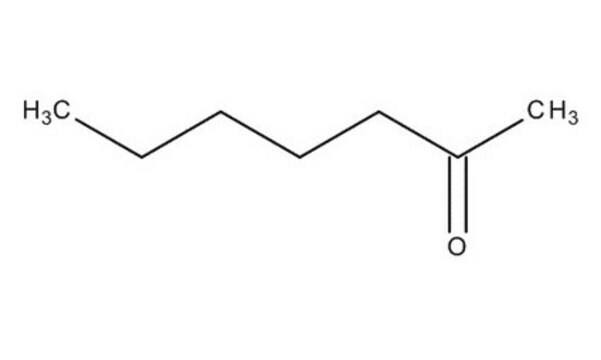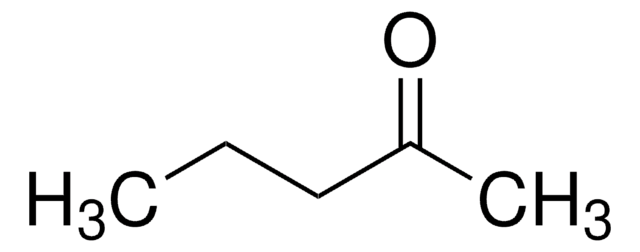537683
2-Heptanone
99%
Sinónimos:
Methyl pentyl ketone
About This Item
Productos recomendados
densidad de vapor
3.94 (vs air)
Nivel de calidad
presión de vapor
2.14 mmHg ( 20 °C)
Análisis
99%
formulario
liquid
temp. de autoignición
739 °F
lim. expl.
1.11 %, 65 °F
7.9 %, 121 °F
técnicas
gas chromatography (GC): suitable
impurezas
≤0.05% (water)
índice de refracción
n20/D 1.408 (lit.)
bp
149-150 °C (lit.)
mp
−35 °C (lit.)
solubilidad
water: soluble 4.21 g/L at 20 °C
densidad
0.82 g/mL at 25 °C (lit.)
cadena SMILES
CCCCCC(C)=O
InChI
1S/C7H14O/c1-3-4-5-6-7(2)8/h3-6H2,1-2H3
Clave InChI
CATSNJVOTSVZJV-UHFFFAOYSA-N
¿Está buscando productos similares? Visita Guía de comparación de productos
Descripción general
Aplicación
Palabra de señalización
Warning
Frases de peligro
Consejos de prudencia
Clasificaciones de peligro
Acute Tox. 4 Inhalation - Acute Tox. 4 Oral - Flam. Liq. 3 - STOT SE 3
Órganos de actuación
Central nervous system
Código de clase de almacenamiento
3 - Flammable liquids
Clase de riesgo para el agua (WGK)
WGK 1
Punto de inflamabilidad (°F)
105.8 °F - closed cup
Punto de inflamabilidad (°C)
41 °C - closed cup
Certificados de análisis (COA)
Busque Certificados de análisis (COA) introduciendo el número de lote del producto. Los números de lote se encuentran en la etiqueta del producto después de las palabras «Lot» o «Batch»
¿Ya tiene este producto?
Encuentre la documentación para los productos que ha comprado recientemente en la Biblioteca de documentos.
Los clientes también vieron
Nuestro equipo de científicos tiene experiencia en todas las áreas de investigación: Ciencias de la vida, Ciencia de los materiales, Síntesis química, Cromatografía, Analítica y muchas otras.
Póngase en contacto con el Servicio técnico












